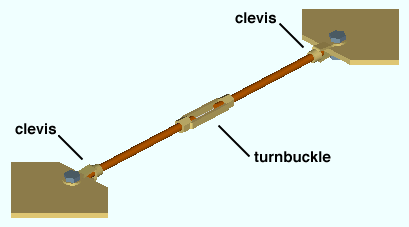Turnbuckle material (topic)

|
A turnbucke that joins two round bars, each of which attaches to a clevis. You can add rod bracing similar to this by entering a round bar description as the " Section size " on the Vertical Brace window. |
Also see :
- Turnbuckle Edit (window for miscellaneous members)
- Turnbuckle Material (window for turnbuckle material and turnbuckle legacy misc members)
page 1 | contents | material types | shapes properties
Submaterial piece marking :
- The default submaterial mark prefix for turnbuckle material, is tb .
page 1 | contents | material types | shapes properties | top
Shape file specifications for turnbuckles :

|
d = rod diameter
n = hole length a = inside length e = inside width g = width |
page 1 | contents | material types | shapes properties | top
Adding turnbuckle sections to the model :
page 1 | contents | material types | shapes properties | top







